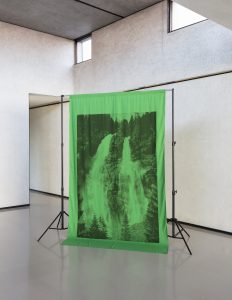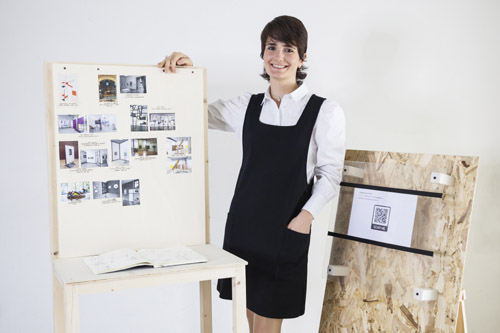“How Many Landscapes?” is the title of the latest exhibition curated by Carlo Sala, open to visitors in Verona until 12 December 2021 at Fondazione Cariverona. The exhibition is an initiative of the Foundation, in collaboration with Urbs Picta and under the artistic direction of Jessica Bianchera. Carlo Sala (Treviso, 1984) is an art critic and curator, he teaches at IUAV Master in Photography in Venice. Among his activities are: the artistic direction of Photo Open Up – International Festival of Photography promoted by the Municipality of Padua, the scientific curatorship of Premio Francesco Fabbri per le Arti Contemporanee and Festival F4 / un idea di Fotografia.
Eleonora Reffo: The exhibition “How Many Landscapes?” starts from an important corpus of works by the famous Italian photographer Gabriele Basilico, owned by the Cariverona Foundation, and it proposes a series of reflections on the relationship between photography and landscape. Is photograpy still a relevant tool for analysing a territory?
Carlo Sala: Photography still has a very strong relationship with the landscape, but according to a series of evolutionary paradigms that have changed over time. The starting point of the exhibition is Gabriele Basilico, and then the exhibition unravels through eight visions that present multiple ways of conceiving the relationship between image and landscape. There are authors such as Paola De Pietri and Jacopo Valentini, to mention two names belonging to very different generations, who maintain a relationship with reality; Davide Tranchina, on the other hand, creates imaginary landscapes; Silvia Mariotti and Alberto Sinigaglia reflect on the imaginary and the contemporary sublime; Francesco Jodice and Filippo Minelli relate territories to social and geopolitical issues; concluding with the works of Alessandro Sambini who proposes images generated by artificial intelligence. The rhetorical question in the title mentions a plurality of views on landscape from our retinal or artificial gaze. Today, those who recount the landscape have to work above all on perception, and each method of transmitting images can change the relationship and understanding of it.
We walk down the street and encounter computer-generated images that perfectly simulate reality. The image is exploited, an object of promotion, no longer an explanatory object. Can we call post-photography the process of recreating photography in digital spaces?
One of the earliest definitions of photography referred to a mirror with memory, suggesting that in its early days it was considered an absolutely objective tool for understanding phenomena. The first applications of photography were in the field of exact sciences and not artistic visions. In the world of post-photography, we know that images can lie and can be subject to manipulation processes of their form and most of all of their meaning. I am among those who argue that images are the last frontier of biopolitics, because they are able to characterize our actions in society by conditioning purchases, political choices and even feelings. Today, the image is a fluid, metamorphic element; therefore, depending on tagging and reception channels, it can undergo strong superstructures of meaning and change. The artists’ task is to try deconstructing these processes and make them evident. As Georges Didi-Huberman argues, images are overdetermined objects. I think that an approach aimed at the complexity of images would help us to better understand not only visual phenomena, but also social and cultural ones. Having “good antibodies” to understand the messages behind visual communication would help us to be more emancipated citizens.
Your latest book published by Silvana is “Stati di tensione. Conversazioni su immagine, società e politica (States of tension. Conversations on image, society and politics)”. In the past you have defined the role of the editor as that of “ferryman”. In what terms did you play this role in the book?
The book is the result of a request to reinterpret, on a curatorial level, the collections of a major institution such as the Museum of Contemporary Photography in Cinisello Balsamo: the most important Italian collection of photography, with almost two million works, in order to generate an exhibition. I felt the need to ask myself what is the role of the curator in the relationship with such a heritage and with the museum as a social activator, considering the works of art in a dialogue with history. I started to hold studio visits by asking the various authors about the political function of the image today, starting from their practice. With Jodice, we discussed the relationship between image and international geopolitics; with Lisetta Carmi, we discussed how art can give a voice to those who do not have one; with Letizia Battaglia, we talked about the splendour and contradictions of Palermo, dominated by the Mafia; with Mario Cresci, we discussed how processes linked to photographic action in certain territories must have a very strong relationship with the community and not be acts of pure appropriation.
What characterizes the younger generation of photographers in Italy?
The younger generations of photographers have a plurality of ways of expressing themselves. What characterises this generation, despite the apparently formal rendering, is the common awareness of the potential of images and their non-neutral status. They are authors who study and reflect, through their work, how the image is made, received and used by people.
You are a professor at the Master in Photography at the IUAV University of Venice. Do you have any advice for a young curator?
The discipline in which we operate has radically changed, and it is often believed that an inner training is sufficient. Acting as a curator today means being a “seismograph” of what is happening in society. My advice is to have a profound relationship with the world of art, but to remember that an interdisciplinary way of thinking is necessary and therefore to have mental flexibility in relating several fields of knowledge. The curator does not have to know everything, but, leaving his or her ego aside, he or she should be able to have deep dialogues with other scholars and the community within which he or she operates.
 Filippo Minelli, Shape US A/Q’, 2014, fine art print on hahnemühle paper, cm 80×120, Courtesy Ruttkowski;68, Cologne – Paris
Filippo Minelli, Shape US A/Q’, 2014, fine art print on hahnemühle paper, cm 80×120, Courtesy Ruttkowski;68, Cologne – Paris
 Alberto Sinigaglia, Vanishing Sublime, 2021, 220 x180 cm, airbrush print on chroma key cotton, support: black metal stands and bar, Courtesy MLZ Art Dep, Trieste
Alberto Sinigaglia, Vanishing Sublime, 2021, 220 x180 cm, airbrush print on chroma key cotton, support: black metal stands and bar, Courtesy MLZ Art Dep, Trieste
 Francesco Jodice, Venezia. The Precursors Legacy, #004, 2013, Courtesy Fondazione Cariverona
Francesco Jodice, Venezia. The Precursors Legacy, #004, 2013, Courtesy Fondazione Cariverona

In 2019 she obtained a BA Degree in Painting and Visual Arts at NABA (Milan), where she is finishing her MA degree in Visual Arts and Curatorial Studies. Since last years she has been collaborating with cultural realities outside the major centres. As curator she is involved in the realization of multidisciplinary projects aimed at heterogeneous audiences.






NO COMMENT